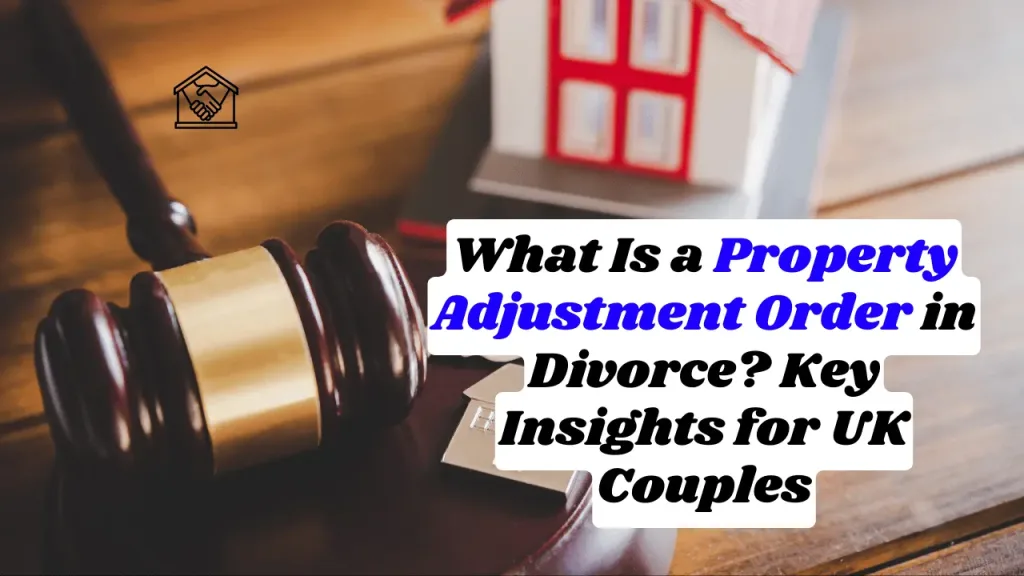What Is a Property Adjustment Order in Divorce? Key Insights for UK Couples
A Property Adjustment Order is a legally enforceable decision made by the court to determine how marital property—such as the family home, savings, pensions, and other assets—will be divided following a divorce or dissolution of a civil partnership. It is designed to ensure a fair and equitable distribution of assets, taking into account the unique needs of both parties and any children involved.
In the UK, divorce settlements involving property are a common issue, as research shows that approximately 50% of divorce cases in the UK involve disputes over financial assets, including the family home. When spouses are unable to reach an agreement on their own regarding the division of property, the court may issue a Property Adjustment Order. This falls under the broader category of financial orders in family law and typically focuses on the family home, which is often the most significant asset.
Table of Contents
Purpose of a Property Adjustment Order
The primary aim of a Property Adjustment Order is to ensure fair redistribution of marital assets. It may involve:
- Transferring property ownership to one party.
- Delaying the sale of the property until specific conditions are met (e.g., children reaching adulthood).
- Creating financial stability for a dependent spouse or children post-divorce.
These orders are particularly important in addressing the unique financial needs of divorcing parties when assets are intertwined.
When Might You Need a Property Adjustment Order?
A Property Adjustment Order becomes necessary when:
- Disputes Over Ownership: Couples cannot agree on who retains the marital property.
- Children’s Welfare: Housing arrangements are required for dependents.
- Complex Asset Distribution: Multiple properties, pensions, or investments require clear division.
Such orders are most commonly sought during contested divorce or dissolution proceedings.
Legal Basis for Property Adjustment Orders
The legal framework for Property Adjustment Orders is primarily derived from:
- Matrimonial Causes Act 1973
- Civil Partnership Act 2004
Courts have wide discretion to ensure that outcomes meet the needs of both parties and protect the interests of any children involved.
Types of Property Adjustment Orders
1. Transfer of Property Order
This is the most common type of Property Adjustment Order. It transfers ownership of marital assets such as real estate, shares, or insurance policies to one spouse. The court may also require financial compensation, such as a lump sum or transfer of other assets, to balance the distribution.
Examples
- Transferring the family home to the primary caregiver of children.
- Transferring a rental property to one spouse as part of an asset split.
2. Settlement of Property Order
This order places the property into a trust for the benefit of one or both parties or their children. The beneficial interest in the property changes immediately upon issuance.
a) Mesher Order
- Purpose: Delays the sale of the marital home until specific conditions are met (e.g., the youngest child turning 18 or completing education).
- Structure: Both spouses retain an interest in the property, with agreements on mortgage contributions and upkeep.
b) Martin Order
- Purpose: Allows one spouse to live in the marital home for life or until remarriage.
- Usage: Ideal when there are no children and the leaving spouse has no immediate financial need for the property sale.
3. Other Relevant Orders
- Clean Break Order: Ensures financial independence between parties post-divorce.
- Lump Sum Order: Provides financial compensation for property rights relinquished by one party.

How Does the Court Decide on a Property Adjustment Order?
When deciding on a Property Adjustment Order, courts evaluate several factors to ensure fairness:
- Duration of Marriage: Longer marriages often result in more equal asset division.
- Children’s Needs: Courts prioritize the housing stability of dependent children.
- Financial Resources: Current and anticipated incomes, pensions, and other assets are considered.
- Contributions: Non-financial contributions, such as childcare, are also recognized.
- Age and Health: The physical and emotional wellbeing of both parties are taken into account.
Application Process for a Property Adjustment Order
Eligibility
You can apply for a Property Adjustment Order after filing for divorce or dissolution and receiving a Conditional Order.
Steps to Apply
- Provide Financial Disclosure
- Complete Form E to disclose all assets, income, and liabilities.
- Attempt Mediation
- Attend a Mediation Information & Assessment Meeting (MIAM).
- Explore resolution with the help of a trained mediator.
- Apply to Court
- If mediation fails, file for a Consent Order (if both agree) or a Financial Order (if there is disagreement).
- Court Hearing
- Submit evidence, such as valuations and financial disclosures.
- The court decides based on factors like fairness, child welfare, and marital contributions.
Documentation Required
- Completed Form E (financial disclosure).
- Proof of mediation attempts (MIAM certificate).
- Property valuations and mortgage statements.
Benefits of a Property Adjustment Order
- Ensures Fairness: Provides a clear and enforceable division of assets.
- Protects Vulnerable Parties: Safeguards the financial interests of dependent spouses or children.
- Stabilizes Housing: Offers solutions like delayed sales to maintain stability for children.
Limitations of a Property Adjustment Order
- High Costs: Court proceedings and legal fees can be expensive.
- Complexity: Requires overcoming extensive legal procedures.
- Delays: Orders like Mesher can prolong financial ties between spouses.
FAQs About Property Adjustment Orders
Can I Apply for a Property Adjustment Order After Divorce?
Yes, you can apply post-divorce, though it’s often advisable to address financial settlements during divorce proceedings.
What Happens If I Disagree With the Order?
Appeals can be made, but you must demonstrate a legal error or significant oversight by the court.
Can a Property Adjustment Order Be Changed Later?
In rare cases, significant changes in circumstances may warrant adjustments.
What Assets Cannot Be Split in a Divorce in the UK?
Typically, assets acquired before the marriage or those considered “non-matrimonial” (such as inheritance or gifts received by one party) may not be subject to division. However, if these assets were intermingled or contributed significantly to the marital finances, the court may include them in the division.
What Are the Rights to Property After Separation in the UK?
Post-separation, property rights depend on ownership and contributions:
- If the property is jointly owned, both parties have equal rights to reside in and benefit from it.
- For non-marital cohabitation, property rights are limited unless there is a cohabitation agreement or proof of financial contribution.
- For married couples, property distribution is determined by the court in the event of a divorce.
Conclusion
A Property Adjustment Order is a crucial tool for ensuring fairness in divorce settlements. By understanding the process, legal framework, and options available, you can make informed decisions to protect your financial interests.
For tailored advice on Property Adjustment Orders, consult an experienced family law solicitor.
About the Author

Sarah Klein, JD, is a former family law attorney with over a decade of courtroom and mediation experience. She has represented clients in divorce, custody cases, adoption, Alimony, and domestic violence cases across multiple U.S. jurisdictions.
At All About Lawyer, Sarah now uses her deep legal background to create easy-to-understand guides that help families navigate the legal system with clarity and confidence.
Every article is based on her real-world legal experience and reviewed to reflect current laws.
Read more about Sarah
About the Author

Sarah Klein, JD, is a former civil litigation attorney with over a decade of experience in contract disputes, small claims, and neighbor conflicts. At All About Lawyer, she writes clear, practical guides to help people understand their civil legal rights and confidently handle everyday legal issues.
Read more about Sarah
